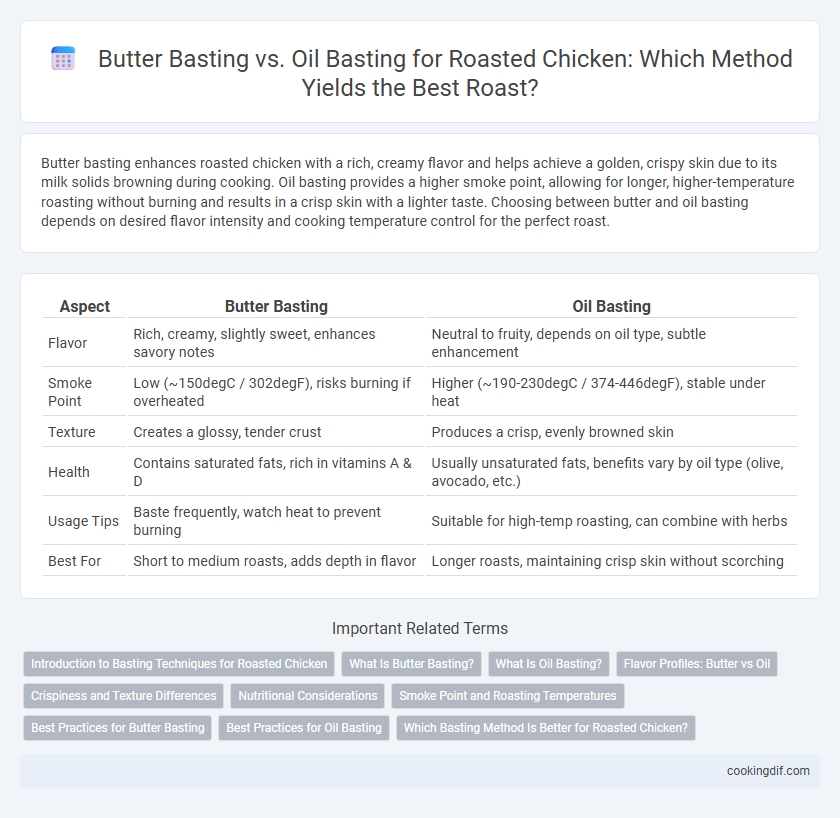Butter basting enhances roasted chicken with a rich, creamy flavor and helps achieve a golden, crispy skin due to its milk solids browning during cooking. Oil basting provides a higher smoke point, allowing for longer, higher-temperature roasting without burning and results in a crisp skin with a lighter taste. Choosing between butter and oil basting depends on desired flavor intensity and cooking temperature control for the perfect roast.
Table of Comparison
| Aspect | Butter Basting | Oil Basting |
|---|---|---|
| Flavor | Rich, creamy, slightly sweet, enhances savory notes | Neutral to fruity, depends on oil type, subtle enhancement |
| Smoke Point | Low (~150degC / 302degF), risks burning if overheated | Higher (~190-230degC / 374-446degF), stable under heat |
| Texture | Creates a glossy, tender crust | Produces a crisp, evenly browned skin |
| Health | Contains saturated fats, rich in vitamins A & D | Usually unsaturated fats, benefits vary by oil type (olive, avocado, etc.) |
| Usage Tips | Baste frequently, watch heat to prevent burning | Suitable for high-temp roasting, can combine with herbs |
| Best For | Short to medium roasts, adds depth in flavor | Longer roasts, maintaining crisp skin without scorching |
Introduction to Basting Techniques for Roasted Chicken
Butter basting enhances roasted chicken by adding rich flavor and promoting a crispy, golden skin through its milk solids and natural fats. Oil basting, often using olive or vegetable oil, provides a higher smoking point that prevents burning and creates a moist, evenly cooked chicken. Both techniques improve juiciness and texture, but butter offers deeper flavor while oil offers better heat tolerance.
What Is Butter Basting?
Butter basting involves spooning melted butter continuously over roasted chicken to enhance flavor and promote a golden, crispy skin. The milk solids in butter contribute to a rich taste and help the surface brown more evenly compared to oil. This technique also adds moisture and a characteristic buttery aroma that elevates the overall roast chicken experience.
What Is Oil Basting?
Oil basting involves spooning hot oil over chicken during roasting to enhance moisture retention and promote even browning, creating a crispier skin compared to butter. Oils with high smoke points such as olive oil or avocado oil are preferred for their stability at roasting temperatures. This technique improves heat conduction and flavor absorption without the risk of butter burning.
Flavor Profiles: Butter vs Oil
Butter basting imparts a rich, creamy flavor with subtle nutty undertones that enhance the roasted chicken's natural sweetness, creating a luxurious mouthfeel. Oil basting offers a more neutral, slightly fruity or earthy taste depending on the oil type, allowing the chicken's inherent flavors to shine while promoting crisp, golden skin. The choice between butter and oil basting significantly influences the final flavor profile, with butter providing depth and indulgence and oil contributing lightness and a crisp texture.
Crispiness and Texture Differences
Butter basting enhances roasted chicken with a rich, golden crust and a slightly caramelized, buttery flavor that contributes to a tender, moist interior. Oil basting, typically using high smoke point oils like canola or vegetable oil, promotes a crispier skin due to its ability to withstand higher roasting temperatures without burning. The choice between butter and oil impacts texture, with butter providing a softer, more flavorful bite and oil delivering a crunchier, more pronounced crispness.
Nutritional Considerations
Butter basting imparts rich flavor and adds saturated fats, which may raise cholesterol levels if consumed excessively, while also providing fat-soluble vitamins like A and E. Oil basting, especially with oils high in unsaturated fats such as olive or avocado oil, supports heart health by reducing LDL cholesterol and supplying beneficial antioxidants. Choosing between butter and oil basting depends on dietary goals, as oil offers healthier fat profiles, whereas butter enhances taste but increases saturated fat intake.
Smoke Point and Roasting Temperatures
Butter basting enhances roasted chicken with rich flavor but has a lower smoke point around 350degF (175degC), making it less ideal for high-temperature roasting above 400degF (204degC), which can cause butter to burn and create off-flavors. Oil basting, particularly with oils like avocado or grapeseed oil, supports roasting at higher temperatures up to 520degF (271degC) due to its higher smoke point, preserving moisture without smoke or bitterness. Balancing roasting temperature with the chosen fat's smoke point optimizes flavor development and prevents flaming or acrid residue.
Best Practices for Butter Basting
Butter basting enhances roasted chicken by adding rich flavor and promoting even browning through its natural milk solids, which caramelize during cooking. Best practices for butter basting include frequently spooning melted butter over the chicken skin to maintain moisture and employing aromatics like garlic and herbs for infused taste. Using clarified butter prevents burning, ensuring a crisp, golden crust while retaining the chicken's juiciness throughout roasting.
Best Practices for Oil Basting
Oil basting for roasted chicken enhances browning and crispiness by evenly distributing heat and retaining moisture, best achieved using high smoke point oils like avocado or grapeseed oil. Applying oil frequently during roasting helps prevent drying while creating a golden, flavorful crust. For optimal results, pour oil gradually and baste every 15-20 minutes to maintain consistent heat and promote even cooking.
Which Basting Method Is Better for Roasted Chicken?
Butter basting offers richer flavor and crispier skin for roasted chicken due to its milk solids caramelizing during cooking, while oil basting provides a higher smoke point, preventing burning at higher temperatures. Butter's ability to infuse the meat with a creamy taste complements herbs and garlic, enhancing overall succulence. For optimal balance, combining butter for flavor and oil for heat stability can improve both texture and moisture retention in roasted chicken.
Butter basting vs oil basting for roasted chicken Infographic

 cookingdif.com
cookingdif.com